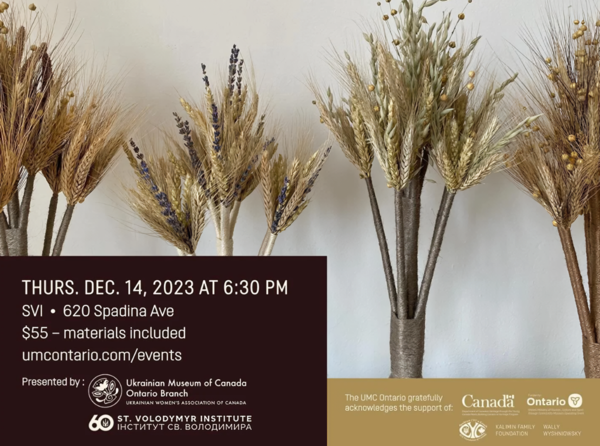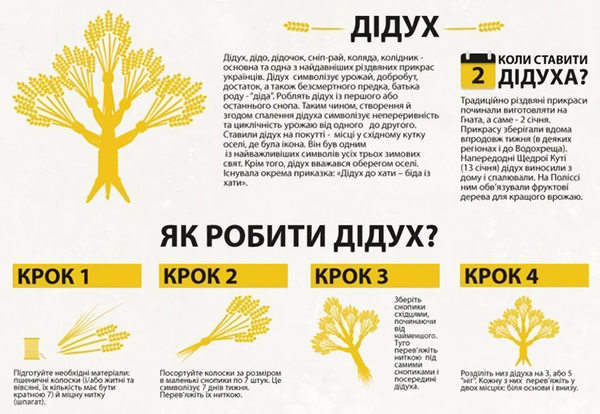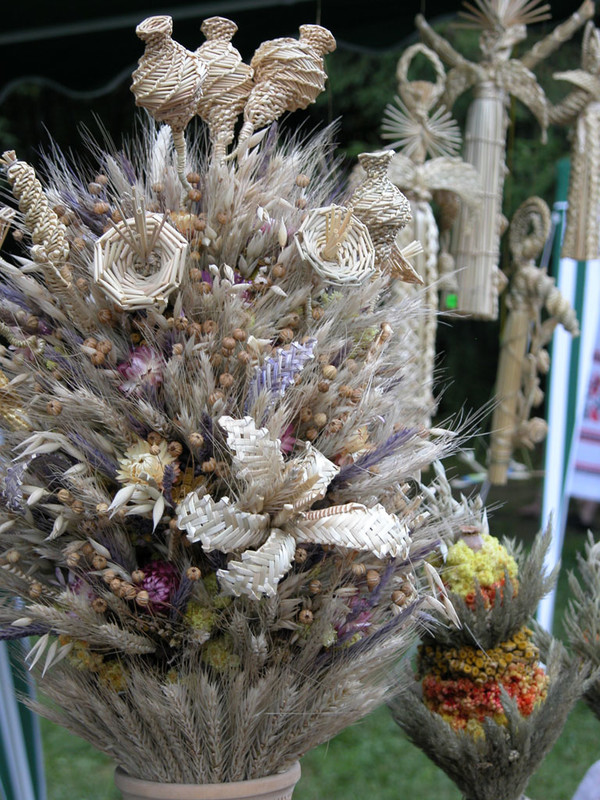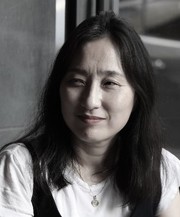The Autumn of Ukraine: Didukh and the Memory of the Community

[아츠앤컬쳐] 우크라이나의 9월은 단순한 계절의 변화 그 이상이다. 들판은 황금빛으로 물들고, 햇살은 부드러워지며, 공기에는 서늘한 기운이 감돌기 시작한다. 이 시기는 전통적으로 농경 사회였던 우크라이나에서 수확의 끝자락이자 새로운 사이클의 준비기이기도 하다. 바로 이때, 조용히 등장하는 것이 있다. 바로 ‘디두흐(Didukh)’다.
디두흐는 보통 밀 이삭이나 귀리를 엮어 만든 장식으로, 수확을 마친 뒤 가정에 들여놓는 전통이 있다. 곧고 단단하게 묶인 밀 이삭들은 단순한 곡식을 넘어 조상의 뿌리와 공동체의 기억을 상징한다. 디두흐라는 말 자체가 ‘조상’을 뜻하는 고어에서 유래했듯, 이 장식은 조상의 숨결이 깃든 신성한 존재로 여겨져 왔다.
우크라이나의 농경 사회 역시 가족 중심의 공동체 문화 위에 형성되었다. 온 가족이 함께 밭을 일구고, 수확한 곡식을 나누며, 서로 의지하며 살아왔다. 디두흐는 이러한 정서와 정신을 상징적으로 응축한 오브제였다. 자연의 풍요로움에 감사하는 동시에, 가족과 공동체의 협력에 감사함을 뜻한다.
오늘날 우크라이나 사람들에게도 디두흐는 여전히 특별한 의미를 갖는다. 특히 9월이 되면 농촌뿐 아니라 도시에서도 디두흐를 만들어 가정이나 학교, 문화공간에 비치한다. 단순하고 곧은 그 형상은 바쁜 일상 속에서도 자연과 공동체의 유대감을 상기시킨다.
최근에는 디두흐를 단지 ‘과거의 유물’로 보기보다는, 현대적 감각으로 재해석하려는 시도도 활발히 이어지고 있다. 예술가들은 디두흐를 통해 ‘현대 우크라이나의 자연과 공동체’를 새로운 시각으로 조형해 나간다. 이러한 재해석은 디두흐에 새로운 활력을 불어넣어 여전히 의미있는 전통으로 여겨지고 있다.

예컨대, 캐나다 토론토의 셰브첸코 박물관에서는 지역 우크라이나 공동체와 함께 디두흐 만들기 워크숍을 정기적으로 운영하고 있다. 이 프로그램은 단순한 공예 활동을 넘어, 참가자들이 조상과 자연을 기억하며 공동체의 정체성을 되새기는 의미있는 기회를 제공한다. 유럽 각국의 우크라이나 하우스 (Ukraine House)에서는 크리스마스를 앞두고 디두흐 장식을 만드는 워크숍을 여는 경우가 많고, 특히 덴마크에서는 어린이와 가족이 함께 참여하는 교육 프로그램으로 자리 잡았다.
한편, 우크라이나 내에서도 루츠크, 리비우, 키이우 등지의 박물관과 예술 공간에서는 디두흐를 소재로 한 현대 설치 미술 전시가 열린다. 밀 대신 다양한 식물, 금속, 재활용 자재로 만든 디두흐 작품들은 전통과 현대의 감각을 잇는 새로운 조형 언어가 되어 관객들과 만나고 있다. 이러한 시도는 공동체와 자연, 계절의 흐름이 어떻게 예술적으로 다시 번역될 수 있는지를 보여주는 귀한 장면이다.
디두흐는 말없이 우크라이나의 많은 것을 말해준다. 이 작은 오브제는 단순한 전통 장식을 넘어, 농경 사회의 기억, 가족 중심의 공동체 가치, 자연에 대한 감사, 그리고 살아 있는 문화의 생명력을 모두 품고 있다. 특히 9월의 우크라이나, 늦여름과 초가을의 경계에서 디두흐는 다시금 만들어지고, 들여지고, 바라보게 된다. 그 안에는 단지 밀 이삭이 아니라, 세대를 이어온 우크라이나 사람들의 삶의 방식과 민족 정신이 오롯이 담겨 있다.

The Autumn of Ukraine
: Didukh and the Memory of the Community
September in Ukraine is more than just a seasonal transition. The fields turn golden, the sunlight softens, and a crispness begins to settle in the air. This time of year, traditionally the close of the harvest season, marks not only an end but a quiet preparation for a new cycle in the agrarian calendar. And in the midst of this shift, something humble yet powerful appears: the "Didukh".
The Didukh is a decorative arrangement traditionally made from wheat stalks or oats, brought into the home at the end of the harvest. Every stalk, bundled tightly and upright, symbolizes far more than just grain—it embodies ancestral roots and the memory of the community. The word "Didukh" itself originates from an archaic term meaning “grandfather” or “ancestor,” and the object has long been considered sacred, believed to carry the breath of the forebears into the household.
In Ukraine’s long agrarian history, society was built around the family and the land. Entire families worked the fields together, shared the harvest, and relied on each other to sustain life. The Didukh was a symbolic reflection of this way of life. It represented gratitude not only for nature’s bounty, but also for the collective labor of the family and the spirit of cooperation within the community.
Even today, the Didukh retains a special place in Ukrainian homes. In September, it is not uncommon to see Didukhs displayed not only in rural villages but also in schools, cultural centers, and even urban apartments. Its simple, upright form reminds people of their ties to the land, their ancestors, and the values of mutual support and resilience that have shaped their identity.

In recent years, there has been a growing movement to reinterpret the Didukh in a contemporary context. Rather than viewing it solely as a relic of the past, artists and cultural practitioners are reshaping the Didukh into a modern symbol of environmental awareness and cultural continuity. These reinterpretations breathe new life into the tradition, keeping it relevant for new generations.
For example, in Toronto, Canada, the Shevchenko Museum regularly hosts Didukh-making workshops with the local Ukrainian community. These workshops are not merely craft activities—they provide participants with a meaningful way to reconnect with their heritage and express gratitude for both nature and shared history. Across Europe, Ukrainian cultural centers such as the Ukraine House organize similar events, especially around Christmas time. In Denmark, Didukh workshops have even been adapted into family-oriented educational programs for children and parents alike.
Within Ukraine itself, cities like Lutsk, Lviv, and Kyiv are seeing a resurgence of Didukh-themed art installations in museums and galleries. Artists are creating Didukhs from alternative materials such as herbs, metals, and recycled items, transforming the traditional form into a modern visual language that blends the past with the present. These installations offer audiences a fresh way to engage with the symbolic intersection of nature, memory, and community.
The Didukh, in its quiet stillness, speaks volumes about the Ukrainian soul. It is far more than a seasonal decoration—it encapsulates an entire worldview rooted in family, labor, reverence for nature, and collective memory. In the gentle days of early autumn, as Ukraine straddles the line between summer’s warmth and winter’s approach, the Didukh appears once again—crafted, displayed, and contemplated. And within each bundle of grain lies not only the memory of the harvest, but the enduring spirit of a people who know how to hold on to their roots, even as they move forward.

글 ㅣ 박수희
(주)구라파랩 대표
해외브랜드 전시 플랫폼 및 마케팅 컨설팅
해외브랜드 B2B & B2C 전문

